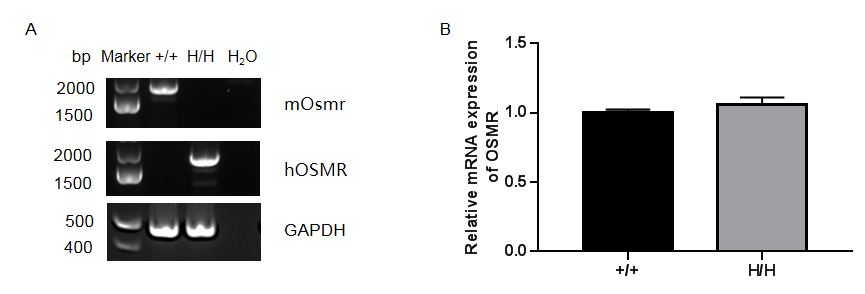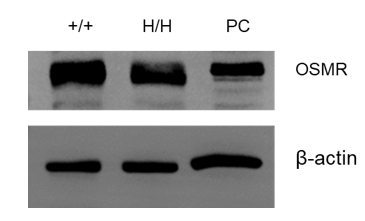B-hOSM/hOSMR mice
| Strain Name | C57BL/6-Osmtm1(OSM)BcgenOsmrtm1(OSMR)Bcgen/Bcgen | Common Name | B-hOSM/hOSMR mice |
| Background | C57BL/6 | Catalog number | 121329 |
|
Aliases |
OSMR: OSMRB; PLCA1; IL-31RB; OSMRbeta; IL-31R-beta | ||

Strain specific analysis of OSMR gene expression in wild type and B-hOSM/hOSMR mice by RT-PCR and RT-qPCR. (A) OSMR mRNA expression. Mouse Osmr mRNA was exclusively detectable in kidney of wild-type mice (+/+). Human OSMR mRNA was only detectable in homozygous B-hOSM/hOSMR mice (H/H), but not in wild type mice. (B) OSMR mRNA expression level. The results show that introduction of hOSMR in place of its mouse counterpart does not change the mRNA expression level.

Strain specific OSMR expression analysis in wild-type C57BL/6 mice and B-hOSM/hOSMR mice by western blot. Kidney tissues were collected from wild-type C57BL/6 mice (+/+) and homozygous B-hOSM/hOSMR mice (H/H), and analyzed by western blot with a known cross-reactive anti-OSMR antibody. 293T cells were used as positive control (PC). The OSMR protein can be detected in wild-type C57BL/6 mice and homozygous B-hOSM/hOSMR mice .

Strain specific OSM expression analysis in homozygous B-hOSM/hOSMR mice by ELISA. Spleen were isolated from wild-type mice (+/+) and homozygous B-hOSM/hOSMR mice (H/H) and stimulated with 2ug/mL anti-mouse CD3 and 5ug/mL anti-mouse CD28 in vitro, cell culture supernates were analyzed by ELISA with species-specific OSM ELISA kit. Mouse OSM was detectable in wild-type mice. Human OSM was exclusively detectable in homozygous B-hOSM/hOSMR mice but not in wild-type mice.
hOSM induced IL-6 secretion in MEFs of B-hOSM/hOSMR mice

hOSM induced IL-6 secretion is blockade by anti-hOSMR antibody in MEFs of homozygous B-hOSM/hOSMR mice. Mouse embryonic fibroblasts (MEFs) were derived from either C57BL/6 mice or B-hOSM/hOSMR mice, and stimulated with different concentrations of mOSM (0-100ng/mL) or hOSM (0-1000ng/mL) for 24h. Supernatants from each well were collected and analyzed for IL-6 expression by ELISA. (A) In the MEFs of C57BL/6 mice, IL-6 can be induced by mOSM in a dose-dependent manner, but not by hOSM. It demonstrates that hOSM can’t be recognized by mouse receptor. (B) In the MEFs of B-hOSM/hOSMR mice, hOSM can induce IL-6 secretion, and the function can be blocked by anti-hOSMR antibodies (in house). The results show that the OSMR signaling function was not influenced by gene humanization. Cells were incubated with antibodies (10μg/mL) for 30 minutes, and stimulated with hOSM.








